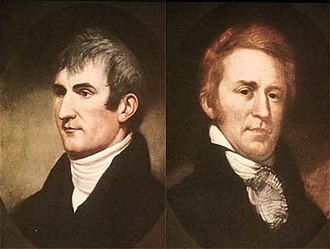Lewis and Clark Expedition
Lewis and Clark Expedition[edit]

The Lewis and Clark Expedition, also known as the Corps of Discovery Expedition, was the first American expedition to cross the western portion of the United States. It began in May 1804 and concluded in September 1806. The expedition was commissioned by President Thomas Jefferson shortly after the Louisiana Purchase in 1803. The primary objective was to explore and map the newly acquired territory, find a practical route across the western half of the continent, and establish an American presence before European powers attempted to claim it.
Background[edit]
In 1803, President Jefferson tasked his personal secretary, Meriwether Lewis, with leading an expedition to explore the lands west of the Mississippi River. Lewis selected William Clark as his co-leader. The expedition was to study the area's plants, animal life, and geography, and to establish trade with local Native American tribes.
Preparation[edit]

The expedition was prepared at Camp Dubois in Illinois, where the Corps of Discovery was assembled. The team consisted of 33 members, including soldiers, civilians, and one Native American woman, Sacagawea, who served as an interpreter and guide.
Journey West[edit]
The expedition set out from Camp Dubois in May 1804, traveling up the Missouri River. They passed through what is now Missouri, Kansas, Iowa, and Nebraska, reaching the Mandan villages in present-day North Dakota by winter 1804.

At Fort Mandan, the expedition spent the winter of 1804-1805. Here, they met Chief Shehaka of the Mandan tribe and gathered valuable information about the terrain ahead.
Crossing the Rockies[edit]
In the spring of 1805, the expedition continued westward, crossing the Rocky Mountains with the help of Sacagawea and her tribe, the Shoshone. The journey through the mountains was arduous, but they eventually reached the Columbia River basin.

Reaching the Pacific[edit]
The expedition reached the Pacific Ocean in November 1805, establishing Fort Clatsop near present-day Astoria, Oregon. They spent the winter of 1805-1806 at Fort Clatsop, preparing for the return journey.

Return Journey[edit]
In March 1806, the expedition began its return journey. They retraced their steps back across the continent, reaching St. Louis, Missouri in September 1806. The expedition was hailed as a success, having gathered extensive information about the western territories and established American claims to the Pacific Northwest.
Legacy[edit]
The Lewis and Clark Expedition provided valuable insights into the geography, biology, and ethnography of the western United States. It paved the way for westward expansion and was instrumental in the development of the American frontier.

Related Pages[edit]
Ad. Transform your life with W8MD's Budget GLP-1 injections from $75


W8MD offers a medical weight loss program to lose weight in Philadelphia. Our physician-supervised medical weight loss provides:
- Weight loss injections in NYC (generic and brand names):
- Zepbound / Mounjaro, Wegovy / Ozempic, Saxenda
- Most insurances accepted or discounted self-pay rates. We will obtain insurance prior authorizations if needed.
- Generic GLP1 weight loss injections from $75 for the starting dose.
- Also offer prescription weight loss medications including Phentermine, Qsymia, Diethylpropion, Contrave etc.
NYC weight loss doctor appointmentsNYC weight loss doctor appointments
Start your NYC weight loss journey today at our NYC medical weight loss and Philadelphia medical weight loss clinics.
- Call 718-946-5500 to lose weight in NYC or for medical weight loss in Philadelphia 215-676-2334.
- Tags:NYC medical weight loss, Philadelphia lose weight Zepbound NYC, Budget GLP1 weight loss injections, Wegovy Philadelphia, Wegovy NYC, Philadelphia medical weight loss, Brookly weight loss and Wegovy NYC
|
WikiMD's Wellness Encyclopedia |
| Let Food Be Thy Medicine Medicine Thy Food - Hippocrates |
Medical Disclaimer: WikiMD is not a substitute for professional medical advice. The information on WikiMD is provided as an information resource only, may be incorrect, outdated or misleading, and is not to be used or relied on for any diagnostic or treatment purposes. Please consult your health care provider before making any healthcare decisions or for guidance about a specific medical condition. WikiMD expressly disclaims responsibility, and shall have no liability, for any damages, loss, injury, or liability whatsoever suffered as a result of your reliance on the information contained in this site. By visiting this site you agree to the foregoing terms and conditions, which may from time to time be changed or supplemented by WikiMD. If you do not agree to the foregoing terms and conditions, you should not enter or use this site. See full disclaimer.
Credits:Most images are courtesy of Wikimedia commons, and templates, categories Wikipedia, licensed under CC BY SA or similar.
Translate this page: - East Asian
中文,
日本,
한국어,
South Asian
हिन्दी,
தமிழ்,
తెలుగు,
Urdu,
ಕನ್ನಡ,
Southeast Asian
Indonesian,
Vietnamese,
Thai,
မြန်မာဘာသာ,
বাংলা
European
español,
Deutsch,
français,
Greek,
português do Brasil,
polski,
română,
русский,
Nederlands,
norsk,
svenska,
suomi,
Italian
Middle Eastern & African
عربى,
Turkish,
Persian,
Hebrew,
Afrikaans,
isiZulu,
Kiswahili,
Other
Bulgarian,
Hungarian,
Czech,
Swedish,
മലയാളം,
मराठी,
ਪੰਜਾਬੀ,
ગુજરાતી,
Portuguese,
Ukrainian